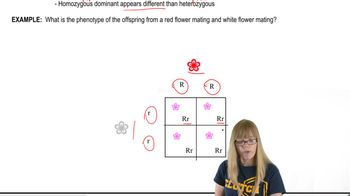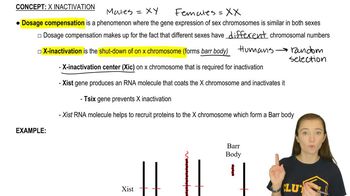Table of contents
- 1. Introduction to Genetics51m
- 2. Mendel's Laws of Inheritance3h 37m
- 3. Extensions to Mendelian Inheritance2h 41m
- 4. Genetic Mapping and Linkage2h 28m
- 5. Genetics of Bacteria and Viruses1h 21m
- 6. Chromosomal Variation1h 48m
- 7. DNA and Chromosome Structure56m
- 8. DNA Replication1h 10m
- 9. Mitosis and Meiosis1h 34m
- 10. Transcription1h 0m
- 11. Translation58m
- 12. Gene Regulation in Prokaryotes1h 19m
- 13. Gene Regulation in Eukaryotes44m
- 14. Genetic Control of Development44m
- 15. Genomes and Genomics1h 50m
- 16. Transposable Elements47m
- 17. Mutation, Repair, and Recombination1h 6m
- 18. Molecular Genetic Tools19m
- 19. Cancer Genetics29m
- 20. Quantitative Genetics1h 26m
- 21. Population Genetics50m
- 22. Evolutionary Genetics29m
2. Mendel's Laws of Inheritance
Pedigrees
Problem 30
Textbook Question
Consider the three pedigrees below, all involving a single human trait.Which combination of conditions, if any, can be excluded?dominant and X-linkeddominant and autosomalrecessive and X-linkedrecessive and autosomal
 Verified step by step guidance
Verified step by step guidance1
Analyze the inheritance patterns in each pedigree to determine if the trait is dominant or recessive. A dominant trait typically appears in every generation, while a recessive trait may skip generations.
Examine the sex distribution of affected individuals in each pedigree. If the trait is X-linked, it will often show a distinct pattern, such as males being more frequently affected in the case of recessive X-linked traits.
For each pedigree, check if the trait can be explained by autosomal inheritance. Autosomal traits affect both sexes equally, while X-linked traits often show a sex bias.
Compare the observed inheritance patterns in the pedigrees with the expected patterns for each of the four conditions (dominant and X-linked, dominant and autosomal, recessive and X-linked, recessive and autosomal). Eliminate any condition that does not match the observed data.
Summarize which combinations of conditions can be excluded based on the analysis of the pedigrees and the inheritance patterns observed.
 Verified video answer for a similar problem:
Verified video answer for a similar problem:This video solution was recommended by our tutors as helpful for the problem above
Video duration:
3mPlay a video:
Was this helpful?
Key Concepts
Here are the essential concepts you must grasp in order to answer the question correctly.
Dominant vs. Recessive Traits
In genetics, traits can be classified as dominant or recessive based on their expression in offspring. A dominant trait only requires one copy of the allele to be expressed, while a recessive trait requires two copies. Understanding this distinction is crucial for analyzing pedigrees, as it influences how traits are inherited and displayed across generations.
Recommended video:
Guided course

Variations on Dominance
Autosomal vs. X-linked Inheritance
Inheritance patterns can also be categorized as autosomal or X-linked. Autosomal traits are located on non-sex chromosomes and affect both sexes equally, while X-linked traits are associated with genes on the X chromosome and often exhibit different patterns of inheritance in males and females. This distinction is vital for interpreting pedigree charts and determining which combinations of conditions are plausible.
Recommended video:
Guided course

X-Inactivation
Pedigree Analysis
Pedigree analysis is a method used to trace the inheritance of traits through generations in a family. By examining the presence or absence of traits in individuals and their relatives, one can infer the mode of inheritance (dominant, recessive, autosomal, or X-linked). This analysis helps in identifying which combinations of inheritance patterns can be excluded based on observed data.
Recommended video:
Guided course

Pedigree Flowchart
Related Videos
Related Practice
Textbook Question
A 'wrongful birth' case was recently brought before a court in which a child with Smith–Lemli–Opitz syndrome was born to apparently healthy parents. This syndrome is characterized by a cluster of birth defects including cleft palate, and an array of problems with the reproductive and urinary organs. Originally considered by their physician as having a nongenetic basis, the parents decided to have another child, who was also born with Smith–Lemli–Opitz syndrome. In the role of a genetic counselor, instruct the court about what occurred, including the probability of the parents having two affected offspring, knowing that the disorder is inherited as a recessive trait.
378
views


